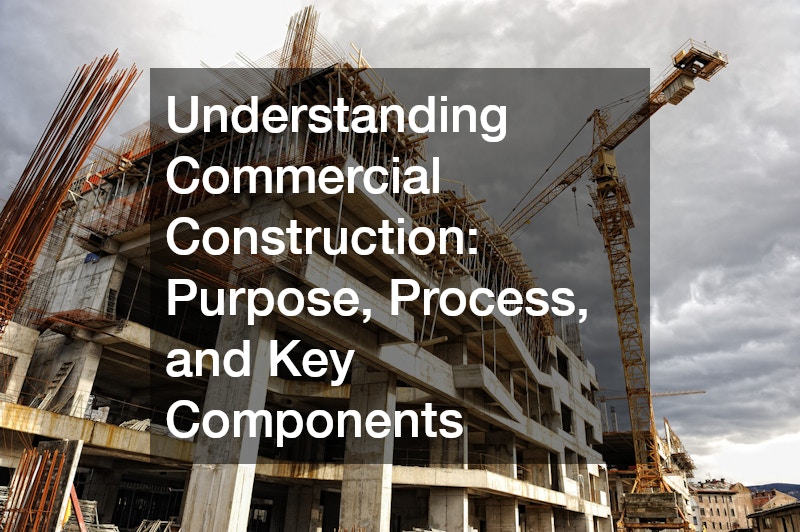
Commercial construction plays a vital role in shaping the built environment of cities, towns, and industrial areas across the world. From towering office buildings to expansive shopping malls and medical facilities, these structures are the backbone of economic development and public functionality. But what exactly is commercial construction, and how does it differ from other types of construction? This article explores the essential aspects of commercial construction, its phases, common building types, and the professionals involved in bringing these complex projects to life.
Defining Commercial Construction
Commercial construction refers to the process of building or renovating structures intended for commercial use. Unlike residential construction, which focuses on homes and apartments, commercial projects involve buildings used for business, retail, government, healthcare, education, or hospitality purposes.
These projects can range from small storefront renovations to multi-story office complexes or manufacturing facilities. The primary goal of commercial construction is to create functional, durable, and safe spaces that support a specific business or institutional operation.
Common Types of Commercial Buildings
There are several categories of commercial structures, each designed with a unique purpose in mind. Some of the most common include:
-
Office Buildings: These range from small professional offices to large corporate headquarters. Design priorities often include layout efficiency, natural lighting, and employee comfort.
-
Retail Spaces: Shopping centers, department stores, and standalone retail outlets are designed with consumer traffic and merchandising in mind.
-
Healthcare Facilities: Hospitals, clinics, and medical offices require specialized construction to accommodate strict safety regulations, equipment needs, and patient care.
-
Educational Institutions: Schools and universities must balance security, accessibility, and adaptability to serve students and staff effectively.
-
Hospitality and Entertainment: Hotels, restaurants, theaters, and event centers demand a focus on guest experience, aesthetics, and regulatory compliance.
-
Industrial and Warehousing: These buildings prioritize durability and space efficiency for manufacturing, logistics, or storage operations.
Each of these building types requires a different approach to layout, design, and materials, depending on the end-use and operational requirements.
Phases of a Commercial Construction Project
A typical commercial construction project involves several key stages. While timelines and tasks can vary depending on the size and scope of the project, the general process includes the following phases:
1. Planning and Development
This initial stage involves assessing the feasibility of the project. Land acquisition, zoning regulations, building codes, and environmental impact are evaluated. The project owner collaborates with architects, engineers, and city officials to determine project requirements and secure necessary approvals.
2. Design and Engineering
During the design phase, architects create detailed drawings and blueprints. These designs focus on both aesthetics and function, incorporating considerations such as traffic flow, energy efficiency, accessibility, and safety. Engineers then ensure the structure can support its intended use by addressing aspects like load-bearing capacity, electrical systems, and HVAC.
3. Pre-Construction
This phase includes finalizing contracts, selecting subcontractors, and ordering materials. A construction manager or general contractor is typically assigned to oversee timelines, budgets, and resource coordination. Permits and insurance are secured, and the site is prepared for building to begin.
4. Construction
The construction phase is where the physical work begins. It includes site clearing, excavation, laying foundations, framing, installing systems, and finishing work. Coordination is key during this phase to ensure trades such as plumbing, electrical, and mechanical work are completed in the correct sequence. Safety protocols and inspections are strictly followed throughout this process.
5. Post-Construction
After the physical structure is complete, a final inspection ensures the building meets all regulatory standards and project specifications. Any outstanding issues, known as punch-list items, are resolved. The building is then handed over to the owner, often with a walkthrough and maintenance documentation.
Professionals Involved in Commercial Construction
Commercial construction projects require the collaboration of multiple professionals, each playing a critical role in the project’s success. These typically include:
-
Project Owners or Developers: Individuals or organisations funding and overseeing the project.
-
Architects and Engineers are responsible for the building’s design, structural integrity, and compliance with codes.
-
General Contractors: Oversee all aspects of the construction process and manage subcontractors.
-
Subcontractors: Specialised workers such as electricians, plumbers, roofers, and HVAC technicians who perform specific tasks.
-
Construction Managers: Often serve as a liaison between the owner and contractors, ensuring schedules and quality standards are met.
-
City Officials and Inspectors: Ensure that the construction complies with zoning laws, safety regulations, and building codes.
The success of a commercial construction project depends on strong communication and coordination among these parties.
Whether it’s a new hospital wing, a high-rise office tower, or a revitalised retail space, commercial construction helps transform ideas into tangible, usable realities. Understanding the process and its players offers insight into how the modern world is built—literally from the ground up.

